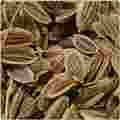About Dill Seeds :
 The characteristic, sweet taste of dill is popular all over Europe, Western, Central and Southern Asia. In Europe, it is mostly used for bread, vegetable (especially cucumber), pickles, and fish; for the last application, the leaves are preferred. Furthermore, it is indispensable for herb flavoured vinegars. See mango on the topic of sour ingredients and vinegar in general.
The characteristic, sweet taste of dill is popular all over Europe, Western, Central and Southern Asia. In Europe, it is mostly used for bread, vegetable (especially cucumber), pickles, and fish; for the last application, the leaves are preferred. Furthermore, it is indispensable for herb flavoured vinegars. See mango on the topic of sour ingredients and vinegar in general.
To make herbal vinegar, a mild vinegar brand must be chosen (e. g., apple vinegar). Herbs, a clove of garlic and, if desired, a few pepper or allspice corns are then macerated for a couple of weeks. Many different herbs have been suggested; cookbooks mention most frequently tarragon, thyme, bay leaves, chervil and cress (nasturtium flowers are particularly decorative). Further, optional herbs are rosemary, lemon balm, lovage, basil and even rue. Lemon-scented herbs (e. g., chameleon plant or lemon myrtle) are particularly effective. Perilla leaves can be employed to give the vinegar both subtle flavour and a most unusual colour. Dill adds depth and body to the product and should never be omitted. When ready, herbal vinegar may be used to prepare delicious sauces; most commonly, however, it is used for salads, which is delightful during winter when fresh herbs are sparse.
In North Eastern Europe and Russia, dill is popular for pickled vegetables, which are there produced in great variety, either by pickling in vinegar or by lactic fermentation. Fresh dill sprigs are mandatory in most recipes of that kind. In these regions with long, cold winters, preserved vegetables are an important source of vitamins and fresh flavour for the otherwise dull winter diet. Dill is also one of the few herbs used in the cooking of the Baltic states, where chopped dill is a frequent decoration on various foods (e. g., boiled potatoes), similar to the use of parsley and chives in other European countries.
Fresh dill leaves (dillweed) is a kind of «national spice» in Scandinavian countries, where fish or shellfish dishes are usually either directly flavoured with dill or served together with sauces containing dill. German cooks also tend to use dill mostly for fish soups and stews (see also parsley on bouquet garni). Dill reached the Northern latitudes probably via medieval monasteries, where it was grown as a medicinal herb according to the Capitulare de villis (see lovage).
Dill has, however, retained its popularity in its original homeland, Asia. Dried dill shows up in Georgia’s famous spice mixture, khmeli-suneli (see marjoram) and is also quite popular in Iran, mainly for boiled beans.
In India, however, dried dill fruits are occasionally used to flavour the lentil and bean dishes known as dal [दाल] (see ajwain).
Origin
Central Asia. A related species (A. sowa) is grown in India; its fruits are larger but less fragrant. Therefore, when dill is asked for by an Indian recipe, it is advisable to reduce the amount of dill by about 30 to 50%, unless the book was explicitly written for Westerners.
Most imported dill stems from Egypt, other Mediterranean countries or Eastern Europe.
Plant family
Apiaceae (parsley family).
Used plant part
Of dill, both the dried fruits (misnamed «dill seeds») and the fresh or dried aerial parts («dill weed») are used. Fresh dill herb is much more aromatic than the dried one.
Sensory quality
Sweet and aromatic, intermediate between anise and caraway. The herb, especially when fresh, has a much sweeter fragrance than dried fruits. About anise-like flavourings, see cicely.
Main constituents
The essential oils from leaves (0.35%) and fruits (2 to 4%) differ slightly in composition: In the fruit oil, the main components are carvone (40 to 60%) and limonene (40%), but other monoterpenes appear only in traces (phellandrene, carveol, terpinene and dihydrocarvone). In the leaf oil, the aroma is determined by carvone (30 to 40%), limonene (30 to 40%), phellandrene (10 to 20%) and other monoterpenes; dill ether (a monoterpene ether) is characteristic of dill leaf oil.
Oil from the fruits of Indian dill (Anethum sowa) contains the phenylpropanoid dill apiole (6-allyl-4,4-dimethoxy-1,3-benzodioxol).
